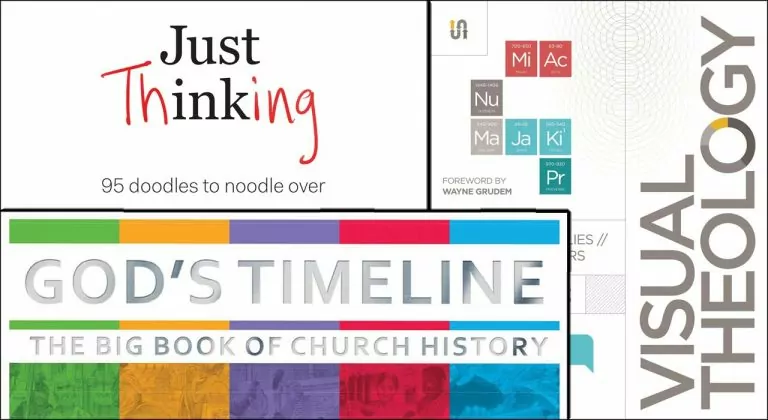VISUAL THEOLOGY: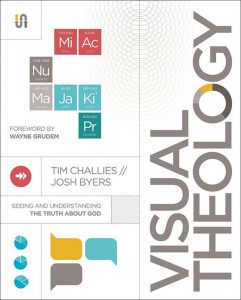
Seeing and understanding the truth about God
by Tim Challies and Josh Byers
2016 / 155 pages
I’ve read and reviewed several systematic theologies. These books were geared towards pastors, theologians, or theological students. They follow the same basic structure and, because they’re Reformed, they tend to say the same things in mostly the same way. Visual Theology has “theology” in the title, and it generally steers in the Reformed direction, but that’s where the similarities end.
Visual Theology is decidedly not directed at the ivory tower – though scholars will certainly reap spiritual benefits if they read it. Instead, it’s for regular people in the pew. It also recognizes that some of those regular people are more visual in their learning style. So, Tim Challies delivers clear prose and Josh Byers illumines with effective infographics. All up, it’s not only a beautiful book, but also pedagogically powerful.
Conventional systematic theologies cover such topics as God, creation, salvation, and the last things. Visual Theology is different; it has four parts:
- grow close to Christ
- understand the work of Christ
- become like Christ
- live for Christ.
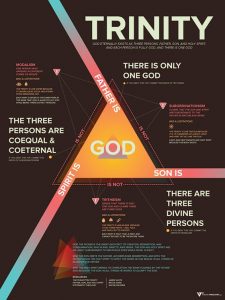 It’s Christ-centered and relationally oriented. It’s theology that, as Challies says, “is about growing in godliness.” You can only grow in godliness in a healthy relationship with Christ. Visual Theology shows why and how. I found valuable insights new to me (especially in the third section on hating and fighting sin), but also many familiar truths expressed or illustrated freshly.
It’s Christ-centered and relationally oriented. It’s theology that, as Challies says, “is about growing in godliness.” You can only grow in godliness in a healthy relationship with Christ. Visual Theology shows why and how. I found valuable insights new to me (especially in the third section on hating and fighting sin), but also many familiar truths expressed or illustrated freshly.
As I mentioned, generally this book leans Reformed. For example, the use of creeds is affirmed; the Westminster Shorter Catechism’s definition of sin is quoted; the real spiritual presence of Christ in the Lord’s Supper is affirmed; and justification is properly defined as a declaration of righteousness. Commendably, Visual Theology teaches a monergistic view of salvation which includes unconditional election.
By the authors’ own admission, the book “is not a thorough introduction to Christian doctrine.” Some readers will detect gaps. Allowing for the intent of the authors, but also for full disclosure to readers of this review, let me mention two.
- Visual Theology is almost completely positive in its presentation of biblical teachings. That means there’s not much, if anything, in the way of exposure or addressing of errors.
- Next, its relational framework is a plus, but it is surprising that the biblical framework for a healthy relationship between God and humanity is missing. There’s no explicit mention of the covenant of grace.
I have one noteworthy concern: the authors are Baptists and this becomes evident in the description of baptism: “The water of baptism represents the washing away of sin, while going into the water and coming back out represents death and new life.” The first part of that sentence is true, and the second part can be true, but more needs to be said. The authors assume immersion of the believer as the norm for baptism. As one would expect from Baptists, the sprinkling of babies is not even in the picture, nor is the relationship between baptism and the covenant of grace. However, this is one short paragraph in an otherwise great book and it is far from being a polemic for the Baptist position.
This book could be useful as edifying reading for a Sunday afternoon. Perhaps it could also be used as a textbook for an adult education class. For those who might use it in an educational setting, there’s also a website with the infographics available as PowerPoint slides and more: visualtheology.church. Visual Theology is innovative in its approach, almost entirely reliable in its content, and attractive in its presentation. You’ll find it both enjoyable and edifying! And you can view dozens of samples of what’s in the book on Tim Challies’ Pinterest page here.
– Wes Bredenhof
*****
GOD’S TIMELINE: 
The big book of Church history
by Linda Finlayson
80 pages / 2018
This book will be a well-used treasure for Christian families and classrooms. It combines text, color, symbols, visuals, infographic timelines and photographs to illustrate how Christ has been building His Church since AD 33.
Finlayson divides the time from AD 33 to 2010 into five periods: Early (33-500), Medieval (497-1500), Reforming (1500-1685), Missionary (1700-1900), and Modern (1900-2010). These are further divided into sub-periods on the timelines. This book is intended for ages 9-15, but it is helpful for any learner including adults.
Within each chapter there are definitions of special terms: heresy, council, creed, canon, Islam, crusade, the five “solas,” ecumenical, etc. The history ranges over all the major denominations and leading personalities of each of the smaller timelines.
Some minor criticisms: The maps could be a little larger, and there is little or no mention of the Black Church, Martin Luther King Jr., etc – the ending of the slave trade is there but not their churches or history. The Missionary and Modern chapters need to be expanded to reflect the building of the church of Christ in Africa, Asia, and Latin America.
Overall, the book covers all the major events, issues, and personages that are always recounted. This is helpful for the intended audience. And the bibliography gives great resources for further study. You can find a couple sample pages here.
– Dennis A. Bratcher
*****
JUST THINKING: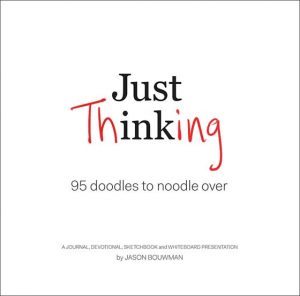
95 doodles to noodle over
by Jason Bouwman
2017 / 188 pages
If you’re a regular reader of Reformed Perspective you may recall some of the Just Thinking “cartoons that have appeared in our pages over the last few years. Author Jason Bouwman, a graphic designer by trade, and a theologian by inclination, has collected 95 of these “theological doodles” and paired each with an appropriate quote, or a few words of explanation, and made the most remarkable book out of them all. Every two-page is a complete though – doodle on one side, reflection on the other, and together they grab the readers’ attention and then hold it. This is a book that can’t be read through quickly – each spread is worth contemplating.
To put it another way, this is theology with an artistic flair, and a devotional of sorts. This is that rare book that would make the perfect high school grad gift, as well as a fantastic birthday present for a seminary professor; we’ve given copies to our teenage nephews as well as to our 80-year-old aunt.
Bouwman has crafted something remarkable here, somehow managing to package “insightful and challenging” with “accessible and creative.” I can’t recommend it enough. You can order a copy and see sample pages at JustThinkingBook.com.
– Jon Dykstra
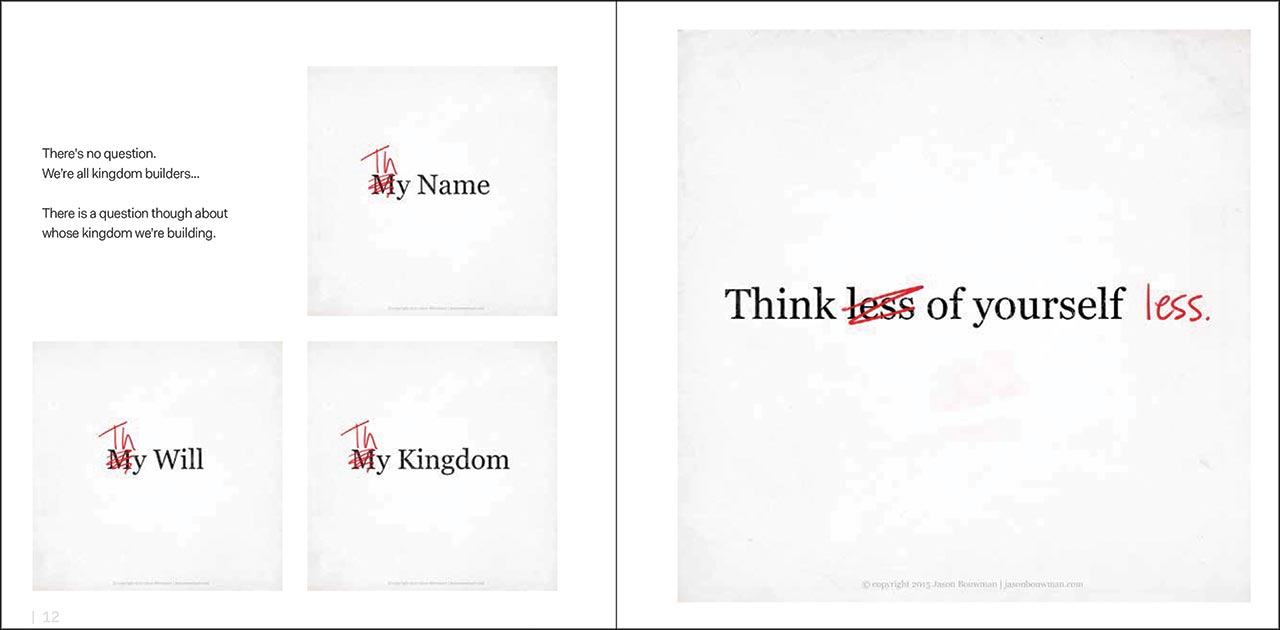 *****
*****







